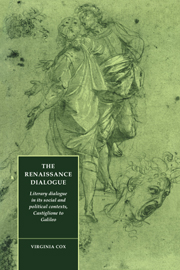 The Renaissance Dialogue
The Renaissance Dialogue Book contents
- Frontmatter
- Contents
- Preface
- 1 Problems of method
- 2 History and invention in the dialogue
- 3 The uses of the dialogue in sixteenth-century Italy: celebration and control
- 4 The uses of the dialogue in sixteenth-century Italy: commerce and courtesy
- 5 Castiglione's Cortegiano: the dialogue as a drama of doubt
- 6 The changing form of the Italian Renaissance dialogue
- 7 The theory and practice of the dialogue in Counter-Reformation Italy
- 8 From the ‘girevole strada’ to the straight and narrow path
- 9 From the open dialogue to the closed book
- Notes
- Bibliography
- Index
2 - History and invention in the dialogue
Published online by Cambridge University Press: 05 December 2011
- Frontmatter
- Contents
- Preface
- 1 Problems of method
- 2 History and invention in the dialogue
- 3 The uses of the dialogue in sixteenth-century Italy: celebration and control
- 4 The uses of the dialogue in sixteenth-century Italy: commerce and courtesy
- 5 Castiglione's Cortegiano: the dialogue as a drama of doubt
- 6 The changing form of the Italian Renaissance dialogue
- 7 The theory and practice of the dialogue in Counter-Reformation Italy
- 8 From the ‘girevole strada’ to the straight and narrow path
- 9 From the open dialogue to the closed book
- Notes
- Bibliography
- Index
Summary
… recitaremo alcuni ragionamenti, i quali già passarono tra omini singularissimi a tale proposito …
Baldassare Castiglione, II libro del Cortegiano (1528)A crucially important structural variable in dialogues, unaccountably neglected by critics, is the historical consistency of their fictional exchange. A dialogue which purports to be a transcription of a real conversation, between speakers whom the reader may plausibly even know, will clearly demand an entirely different kind of reception than one which presents a discussion undefined by place or time, peopled by puppets whose character and views are clearly defined by their role in the economy of the dialogue.
The extent to which historical consistency conditions our reading of a dialogue can be illustrated by looking at a work which exists in both a ‘documentary’ and a fictional version. In the original version of Torquato Tasso's Malpiglio overo della corte (1585), Tasso's discussion of courtiership gains a crucial level of meaning from the identity of the protagonists he chooses. The speakers are a father and son, Lorenzo and Giovanlorenzo Malpiglio, and the author himself, in his customary Platonic guise as a ‘Neapolitan Stranger’. Giovanlorenzo is portrayed as a starryeyed youth, besotted with the glamour of the Ferrarese court, and incapable of imagining a higher calling than the service of a prince. His father, Lorenzo, has misgivings about this: an exile from the fallen republic of Lucca, he is mindful of the family's past as members of an independent ruling élite.
- Type
- Chapter
- Information
- The Renaissance DialogueLiterary Dialogue in its Social and Political Contexts, Castiglione to Galileo, pp. 9 - 21Publisher: Cambridge University PressPrint publication year: 1992


